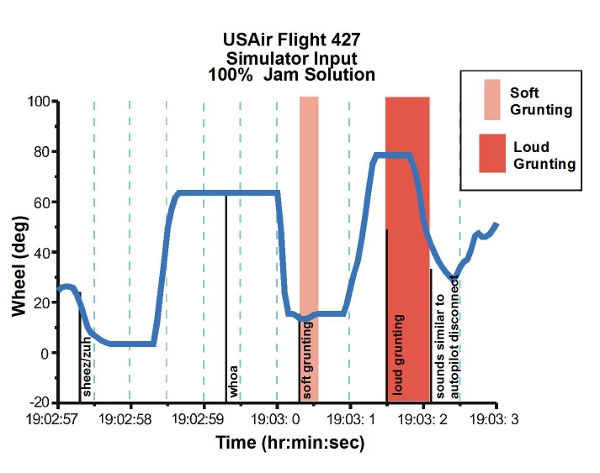Speech Analysis in Accident Investigation
Malcolm Brenner
- brennem@ntsb.gov
Human Performance
Investigator
National Transportation
Safety Board
Popular version of paper 4pSCa1
Presented Thursday afternoon, April 22, 2010
159th ASA Meeting, Baltimore, MD
The National Transportation
Safety Board (NTSB) is a Federal agency that investigates major transportation
accidents in the United States, determines their probable cause, and makes
recommendations to prevent their recurrence.
In its investigations, the Safety Board frequently obtains audio
recordings and, with the support of the scientific community, has used speech
analysis to develop human evidence useful to the investigation. The talk presents two examples.
Shortly after midnight, on March
24, 1989, the U.S. tankship Exxon Valdez grounded on Bligh Reef near Valdez,
Alaska, spilling about 258,000 barrels of crude oil and resulting in
catastrophic damage to the environment.
One issue in the
investigation was whether the master (captain) was impaired by alcohol at the
time of the accident. Toxicology tests
indicated the presence of alcohol in a blood sample obtained 10.5 hours after
the accident, but eyewitnesses provided evidence that the master was not
impaired around the time of the accident.
Therefore, the Safety Board examined Coast Guard recordings for direct
audio evidence.
Samples of the masters
speech were obtained from Coast Guard recordings at five time periods relative
to the accident: 33 hours before, when
the vessel was inbound to Valdez (used as an exemplar of the masters normal
speech); one hour before, when the master made decisions critical to the
accident; immediately after; one hour after; and 9 hours after (used as an
exemplar of the masters speech when awake for more than 24 hours).
Analysis of the masters
speech revealed dramatic differences around the accident that were consistent
with alcohol impairment and that were not evident in exemplar speech samples:
The investigation considered
alternate explanations (based on fatigue, psychological stress, drug effects,
and medical problems), but alcohol impairment provided the best fit of the
available evidence. Based in part on audio
evidence, the Safety Board concluded that the accident reflected the failure
of the master to provide a proper navigation watch because of impairment from
alcohol.
Samples of the audio
recordings will be played at this presentation.
About 7:03 P.M., September 8,
1994, USAir (now USAirways) Flight 427, a Boeing 737-300 airplane, crashed
while on approach to land at Pittsburgh International Airport in clear
weather. All 132 persons on board were
killed.
The cockpit voice recorder (CVR),
recovered from the wreckage, provided an excellent audio record of the last
30.9 minutes of cockpit conversation. It
revealed active pilot responses to the upset, including grunts and
exclamations, but no direct statement of the cause of the problem.
The flight data recorder
(FDR), also recovered from the wreckage, provided limited information about the
motion of major control surfaces.
However, engineering analysis of the FDR data indicated that the
flightpath of the accident closely described that of a rudder hardover event
(a full rudder command maintained for several seconds). Such a hardover event would imply either an
unknown system failure or an unorthodox pilot input, so all investigative
groups searched exhaustively for any plausible mechanism to produce a rudder
hardover. The human performance group,
for example, examined and discounted possibilities based on medical
incapacitation, deliberate action, or panic.
Audio analysis, specifically fundamental frequency and amplitude analysis
of the captains statements, assisted this work by providing evidence on
possible emotional reactions.
After several years,
investigation determined that a rudder reversal sequence was conceptually
possible with the Boeing 737 rudder system that might explain the
accident. Under very rare circumstances,
a hardware failure might cause the rudder to move temporarily opposite to the
direction commanded by the pilot until it reached and maintained a full rudder
command. This sequence was consistent
with all available evidence but, because of its significance, a search was made
for any evidence directly indicating that such a sequence occurred in the
Pittsburgh accident. Audio analysis
provided a possible connection. When the
flying pilots grunts were overlaid on engineering reconstructions of the major
flight control motions, the grunts corresponded perfectly with the motions of a
rudder reversal but did not correspond to any other control input (see attached
graphs).
Audio analysis assisted the
Safety Board in its determination that the rudder surface most likely
deflected in a direction opposite to that commanded by the pilots as a result
of a jam of the main rudder power control unit servo valve secondary
slide. As a result of the Pittsburgh accident
and investigation, industry has retrofit the worldwide fleet of Boeing 737
aircraft with a modified rudder control designed to prevent any such accident
in the future.
Conclusion
The NTSB has examined audio
analysis as an investigative tool and found that it can provide useful
scientific information on human reactions in accident situations. Hopefully, this talk will inspire continued
cooperation with the scientific community to further examine audio responses in
areas such as human fatigue.
References
National Transportation
Safety Board. Marine accident
report: grounding of the U.S. tankship
EXXON VALDEZ on Bligh Reef, Prince William Sound near Valdez, Alaska, March 24,
1989. Washington, DC: National Transportation Safety Board,
1990; NTSB/MAR-90-04.
National Transportation
Safety Board. Aircraft Accident
Report: Uncontrolled descent and
collision with terrain, USAir Flight 427, Boeing 737-300, N513AU, near
Aliquippa, Pennsylvania, September 8, 1994.
Washington, DC: National Transportation
Safety Board, 1999; NTSB/AAR-99-01.

Figure 1.
The timing of pilot grunting sounds overlaid on an engineering reconstruction
of control surface motions during the accident sequence for wheel (top); and
rudder (bottom).